Archive for December, 2018
-
THE SISTERS OF THE CRIB
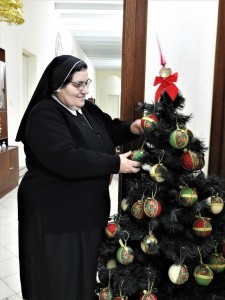 “This place was much livelier when children were around, especially in Christmas,” reminisced 60-year-old Madre Phyllis Agius of Jesus of Nazareth Institute in Żejtun. Around forty years ago, when she became a nun, the institute catered for orphans, teenage girls with family problems, and Muslim refugees. Nowadays, the nuns have dwindled to only nine and the institute serves mainly as a night shelter for the elderly.
“This place was much livelier when children were around, especially in Christmas,” reminisced 60-year-old Madre Phyllis Agius of Jesus of Nazareth Institute in Żejtun. Around forty years ago, when she became a nun, the institute catered for orphans, teenage girls with family problems, and Muslim refugees. Nowadays, the nuns have dwindled to only nine and the institute serves mainly as a night shelter for the elderly.“It was the need to take care of children which made me decide to become a nun. When I was a little girl, I noticed the institute’s orphans attending my same school in Żejtun and I hoped that one day, I would be able to give them all my love and support.”
She was initially approached by a nun while she was participating in a raffle which was being held at the institute as part of the Christmas activities.
“I visited the mechanical crib at this institute each year and like many others, I tried my luck at the raffle. On one of these days, I won the raffle but I had no idea which gift to choose. It was at that point that a nun gave me a pamphlet which read – Why not you? From then on, I began to consider becoming a nun.”
The large mechanical crib which was opened for the public in 1947, was one of the main attractions which brought people to the institute.
“People were simply amazed by this crib and its moving figurines. When it opened for the first time, crowds came from all over the island to see it. There were such long queues that people got restless waiting and the police had to be called in to calm the situation. By time, we became known as the sisters of the crib.”
 “No entrance fee was charged to visit this crib but people gave us donations to support the needs of our institute. Both this crib and also the orphans drew the attention of several benefactors who helped us to live a simple but comfortable life.”
“No entrance fee was charged to visit this crib but people gave us donations to support the needs of our institute. Both this crib and also the orphans drew the attention of several benefactors who helped us to live a simple but comfortable life.”Like Madre Phyllis, when I was young, I remember some of these young children who attended the primary school in Żejtun. They were always very smart and tidy.
“Older nuns recall a time when there were around two hundred children at this institute. There were not as many children when I became a nun, and the last group who lived here around twelve years ago, consisted of just six children. Although the children lived a disciplined life, they were all very dear to us, and some of them are still in contact with us.”
“Our children were always very busy during the Christmas season. Nuns trained them to participate in plays and also in the institute’s choir. A group of nuns who could play instruments organized a small orchestra which accompanied the choir. On Christmas eve, the Institute’s director would attend and he was always very pleased to see everyone having fun.”
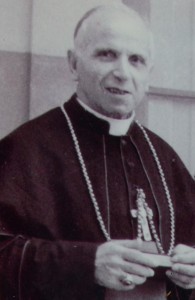 The first director of this institute and orphanage was none other than Bishop Emmanuel Galea, the very person who came up with the idea to construct the large mechanical crib.
The first director of this institute and orphanage was none other than Bishop Emmanuel Galea, the very person who came up with the idea to construct the large mechanical crib.“During the Christmas season, the children attended to many parties and they received several presents. Some of the children were also invited to spend the Christmas with families. It was such a happy time.”
“One of the nuns, Sister Ursola, was an excellent pastry maker. The aroma of baking Christmas cakes and qagħaq tal-għasel was heavenly during those days. Much of these sweets were given to our benefactors as a sign of gratitude.”
As no more children were left and fewer nuns joined the institute, life changed considerably. Now, most of the benfactors are gone and the elderly nuns have to rely on the help of friends and volunteers. Yet Christmas is still a cherished time.
“Three weeks before Christmas, we start with the Advent season which prepares us for the celebration of the Nativity of Jesus. This consists of teachings and readings during the daily mass that takes place at the institute’s church at 7.00am. Nine days before Christmas, we celebrate the novena which consists of readings and singing at the end of the mass.”
The expectation for Christmas triggers also a number of traditions within the institute.
“Volunteers come to help us to decorate the institute’s halls and rooms with cribs, baby Jesus statues, Christmas fathers and Christmas trees. One of the volunteers also takes care of growing vetch for us which is eventually used to decorate the institute’s church together with ponsiettas.”
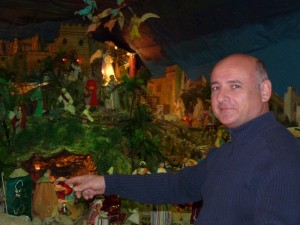 “Joseph Pavia, the nephew of Pawlu Pavia who constructed the mechanical crib, calls to check whether everything is fine with the crib and the figurines. In the meantime, we prepare the items for our Christmas bazaar from which we sell books, toys and crafts prepared by the nuns.”
“Joseph Pavia, the nephew of Pawlu Pavia who constructed the mechanical crib, calls to check whether everything is fine with the crib and the figurines. In the meantime, we prepare the items for our Christmas bazaar from which we sell books, toys and crafts prepared by the nuns.”The day before Christmas eve, Madre Phyllis prepares her renowned chocolate drink which has become a favourite with parishioners.
“My recipe consists of chunks of exquisite chocolate, drinking chocolate, baking chocolate, vanilla drops, sugar, and peel of oranges, lemons and mandarines. I melt and blend eveything together in two large cooking pots and leave the mixture to cook slowly.”
“This chocolate drink and a piece of Christmas cake are then offered to all those who attend to the Christmas eve mass which is celebrated at the institute’s church at 8.00pm. Children are also given a present by Father Christmas.”
The nuns spend Christmas day together at the institute.
“We wake up at 5.45am to say our prayers. Then we have breakfast and at 7.00am we attend to mass. Afterwards, we fill the nuns’ Christmas stockings with small presents which mainly consist of chocolates since they love them. Some of us receive family visits while others welcome the public at our crib. At noon we have lunch and we pray again.”
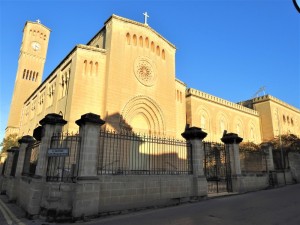 “After enjoying some rest, some of us stand again by the crib to receive the public. More people tend to come at this time, bringing along their families with them. Many people seek this annual opportunity to talk to us. It is pleasant to see that people still trust us and believe that we are a faster way to God,” she said as she smiled.
“After enjoying some rest, some of us stand again by the crib to receive the public. More people tend to come at this time, bringing along their families with them. Many people seek this annual opportunity to talk to us. It is pleasant to see that people still trust us and believe that we are a faster way to God,” she said as she smiled.Indeed, this is the time when people approach them to share their personal problems, seek advice, and ask for prayers. A good number of those attending give them donations to help with the needs of the institute.
“Christmas day ends with more prayers and dinner. Then we gather together to watch tv while enjoying some sweets and a sip of vermouth. After all Christmas is about being with family and this is our family now.”
The Institute of Jesus of Nazareth is located at St Gregory Street in Żejtun.
This year, the mechanical crib will be open between 16th December 2018 and 6th January 2019. Opening hours: 9.30am – noon and 4.00pm – 7.00pm all week.
(This feature was published in the Christmas Times issued with The Times of Malta on 8th December 2018)
-
AND THEY ALL CAME TO SEA
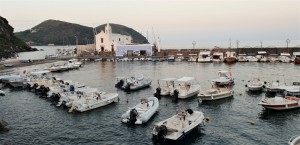 At the centre of the attractive small harbour of Marina Corta in Lipari, there is an unassuming quaint church dedicated to Our Lady of the Snow and to the Souls of Purgatory. One could easily fail to visit this place since fun and life beckons from the several restaurants, cafeterias and shops situated right across in the spacious square. Yet a most unique and pleasant surprise awaits those who decide to step inside.
At the centre of the attractive small harbour of Marina Corta in Lipari, there is an unassuming quaint church dedicated to Our Lady of the Snow and to the Souls of Purgatory. One could easily fail to visit this place since fun and life beckons from the several restaurants, cafeterias and shops situated right across in the spacious square. Yet a most unique and pleasant surprise awaits those who decide to step inside.The church was built in 1545, just five years after the island of Lipari was sacked by the Turkish corsair Barbarossa who took away almost the entire population into slavery. Defiantly constructed on the jutting rocks, the church intended to serve as a point of reference for those who repopulated the island.
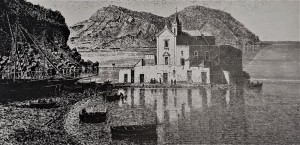 However, along the years, as other chapels and churches were built around Lipari, this church was abandoned and left to its own destiny. Critically close to the sea, the building suffered severe damage, and in recent years, it was on the brink of collapse.
However, along the years, as other chapels and churches were built around Lipari, this church was abandoned and left to its own destiny. Critically close to the sea, the building suffered severe damage, and in recent years, it was on the brink of collapse.On a cold winter day in 2011, with the rough seas hitting mercilessly at this church, a group of locals decided to save this place. They were all saddened by the neglected state of this historical building and they were adamant to do something about it. After they came out with a plan, they discussed their ideas with their parish priest, Fr Giuseppe Mirabito, who agreed at once to collaborate with them.
The Association SS. Cosma and Damiano Marinacorta was established to coordinate this project. The stability of the building was the first thing which had to be addressed quickly. As the members of the association talked about this project with other locals and friends, support came in the form of the required materials and voluntary help. In time, the external part of the church was restored. However, the internal area of the church remained in dire need of restoration.
 As the building started to regain its dignity, the association’s members needed to come up with new ideas to attract visitors to the church. Their main aim was to create more awareness about the historical and cultural value of this building so that more people would help out with this venture, particularly with the funds which were required to restore the church completely.
As the building started to regain its dignity, the association’s members needed to come up with new ideas to attract visitors to the church. Their main aim was to create more awareness about the historical and cultural value of this building so that more people would help out with this venture, particularly with the funds which were required to restore the church completely.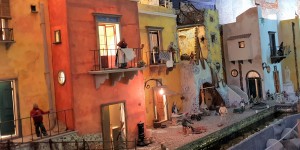 Since it was close to Christmas, they decided to build a crib inside the church. But this was no ordinary crib with religious iconography. Instead, it was laid out to represent the fishing village of Lipari as it was in the old days and it was named Presepe del Mare.
Since it was close to Christmas, they decided to build a crib inside the church. But this was no ordinary crib with religious iconography. Instead, it was laid out to represent the fishing village of Lipari as it was in the old days and it was named Presepe del Mare.Peppuccio Costanzo, one of the association’s members and a fisherman, assisted in the design of this crib which was made of papier-mache. The miniature village was a replica of the real buildings, architecture and life that existed in Lipari around fifty years ago. A number of known village characters were also included in this most unusual crib.
 The crib’s landscape was built along a watercourse with real fish living inside. The crib is mostly populated by fishermen, some of whom are at work while others are idling around. The attention which was given to the details in this crib acts as a time capsule to help visitors visualize better how Lipari looked before it was regenerated to suit the needs of the increasing tourist demands. It also pictures several traditions of the time. Locals may even recognize some of the people represented in the figurines; a number of whom have by now passed away.
The crib’s landscape was built along a watercourse with real fish living inside. The crib is mostly populated by fishermen, some of whom are at work while others are idling around. The attention which was given to the details in this crib acts as a time capsule to help visitors visualize better how Lipari looked before it was regenerated to suit the needs of the increasing tourist demands. It also pictures several traditions of the time. Locals may even recognize some of the people represented in the figurines; a number of whom have by now passed away.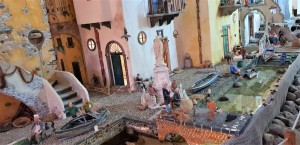 Existing landmarks such as the church of St Joseph and the statue of St Bartholomew serve as identifying marks in the changing village. Gone are most of the old houses which can be seen in the crib. Today, these have been replaced by higher modern buildings. Traditional life as shown in the crib has almost dissolved into nothingness. Tradesmen’s shops have been taken over by modern outlets selling souvenirs or boat rides. The fish seller who called out in the streets, nowadays displays his fish in a van. Women do not carry water jugs anymore; tap water is now readily available. Clothes are no longer washed in public places; washing machines take care of this matter. The young man who played the guitar beneath the balcony of the girl he loved will today send her an sms instead.
Existing landmarks such as the church of St Joseph and the statue of St Bartholomew serve as identifying marks in the changing village. Gone are most of the old houses which can be seen in the crib. Today, these have been replaced by higher modern buildings. Traditional life as shown in the crib has almost dissolved into nothingness. Tradesmen’s shops have been taken over by modern outlets selling souvenirs or boat rides. The fish seller who called out in the streets, nowadays displays his fish in a van. Women do not carry water jugs anymore; tap water is now readily available. Clothes are no longer washed in public places; washing machines take care of this matter. The young man who played the guitar beneath the balcony of the girl he loved will today send her an sms instead. The crib’s culmination and originality is certainly in the warm and simple nativity scene where fishermen are greeting baby Jesus, not sheperds. Colourful fishing boats and straw fishermen’s baskets are present in the area, not hills and sheep. An angel sings besides a balcony of a house not on top of a cave.
The crib’s culmination and originality is certainly in the warm and simple nativity scene where fishermen are greeting baby Jesus, not sheperds. Colourful fishing boats and straw fishermen’s baskets are present in the area, not hills and sheep. An angel sings besides a balcony of a house not on top of a cave.As people came to visit this crib, it became evident that this was more than a seasonal project. Soon it was decided that this crib should remain in this church as a cultural symbol of Lipari. The crib would be visitable all around the year and whoever paid the entrance fee of €1 would be assisting in the restoration of the church.
 By now, Presepe del Mare has come to form part of the cultural identity of Lipari. Besides presenting the craftsmanship of those who made it, the crib is also a relevant reminder of the importance of keeping traditions alive and of conserving the remaining architecture of the area.
By now, Presepe del Mare has come to form part of the cultural identity of Lipari. Besides presenting the craftsmanship of those who made it, the crib is also a relevant reminder of the importance of keeping traditions alive and of conserving the remaining architecture of the area.Info about Lipari: The island of Lipari is the largest of the Aeolian volcanic archipelago. Nowadays, its population is around 12,700, although it generally reaches 20,000 during the tourist season, from May to September. Due to its charming character, historical value and holiday atmosphere, Lipari is a top destination. Fast ferry connections from Sicily all stop at this island, as well as plenty of boats and hydrofoils, making it the ideal place to reach the other islands in the archipelago – Vulcano, Salina, Stromboli, Filicudi, Alicudi, Panarea and Basiluzzo.
(This feature was published in The Christmas Supplement issued with The Sunday Times of Malta on 2nd December 2018)
Travelogue
Archives
Recent Posts
- A MATTER OF FATE
- MALTA’S PREHISTORIC TREASURES
- THE MAGIC IS IN THE DETAIL
- THE SELLING GAME
- NEVER FORGOTTEN
- Ġrajjiet mhux mitmuma – 35 sena mit-Traġedja tal-Patrol Boat C23
- AN UNEXPECTED VISIT
- THE SISTERS OF THE CRIB
Comments
- Pauline Harkins on Novella – Li kieku stajt!
- admin on IL-KARNIVAL TRAĠIKU TAL-1823
- Albert on IL-KARNIVAL TRAĠIKU TAL-1823
- Martin Ratcliffe on Love in the time of war
- admin on 24 SENA ILU: IT-TRAĠEDJA TAL-PATROL BOAT C23